|
|

Handbook on Viewing Buddhist Statues
A totally wonderful
book by Ishii Ayako.
Some images
at this site were
scanned from this
book; Japanese
language only;
192 pages;
80+ color photos
Click here to
buy book at Amazon
SANSKRIT IMAGES
With permission from TOBIFUDO (J-Site)
|
|

BUSSOKUSEKI 仏足石
STONE FOOTPRINTS OF THE BUDDHA
PLUS THE 32 SIGNS OF BUDDHA
Click here for details on the Historical Buddha
FOOTPRINTS OF THE BUDDHA IN EARLY BUDDHIST ART. For four centuries after Gautama’s death (approx. 483 BC), legends and facts about the Historical Buddha, his dialogues and his sayings, were preserved only in the memories of monks and followers. There were no written records or artistic representations. Like the Hindu Brahmins, the early Buddhists believed that religious knowledge was too sacred to be written down, too sacred to be etched in stone or wood. In those early years, when overt representations of the Buddha image were taboo, the main artistic vehicle for symbolizing the Buddha’s presence was to show the Buddha's “footprint.” These footprints of early Buddhist artwork can be found throughout Asia, often in narrative reliefs depicting key episodes in the Buddha's life, and thereby indicating his personal presence.
These footprints are often engraved with various Buddhist symbols. One of the most frequently used symbols in early Buddhism was the Svastikah (either left-facing 卍 or right-facing 卐). Many centuries later, in the 20th century, it was unfortunately adopted by Nazi Germany, who used it (the swastika) on their flag and armbands.
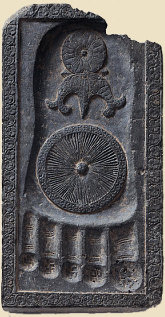
Footprint of Buddha (Gandhara / Swat Area, Pakistan)
2nd - 3rd centuries A.D., H-75.5 D-17 W-48.5 cm.
Photo courtesy: miho.or.jp/english/
See catalog entry for this item.
ABOVE & BELOW: This Buddha footprint (from the Archaeological Museum in Pakistan) is thought to be the one mentioned in the travel records of the Chinese monks Faxien and Xuanzang, who made their pilgrimages in the 5th and 7th centuries respectively. Such footprints typically show the Svastikah 卍 symbol on each toe.
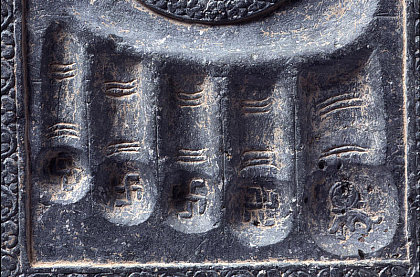
Closeup of prior photo

卍 or 卐 (pronounced “manji” in Japan). A symbol originating in India (Skt. Svastikah, Jp. Kyōji 胸字). Means “to be fortunate.” The word stem SVASTI can be divided into SU (SV), meaning good or well, and ASTI (ASTIKAH), meaning is or being. In modern India, the word means auspicious. In Japan it is used as a symbol of Buddhist faith, one found frequently on statues of the Buddha (Nyorai) and Bodhisattva (Bosatsu), and one of the 32 Marks of the Buddha (Sanjūnisō 三十二相). It represents the ”possession of all virtues” in Japanese Buddhism, and is used on maps to denote temples.

Yakushiji Temple 薬師寺 in Nara is home to the oldest Buddha footprints in Japan. Dated to the Nara period (710-794), the footprints are engraved in stone and are about 48 cm in height. The engravings on this stone are also found on the feet of the temple’s famed gilt black bronze statue of Yakushi Buddha.
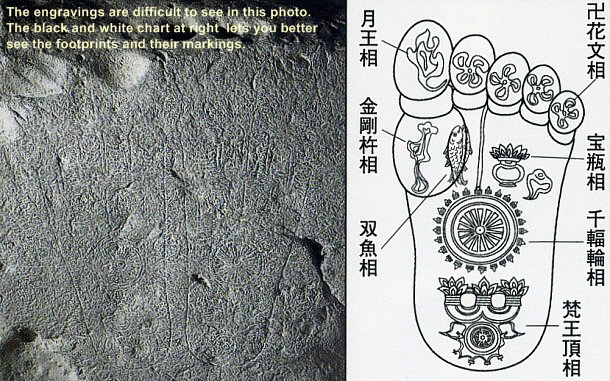
<Source: Magazine named 日本の仏像, Japan's Buddha Statues, 9. Aug. 2007 edition>
TRANSLATION FOR ABOVE MARKINGS
- Man-Hanamon-sō 卍花文相. Lit. "Decorative Version of 卍 Symbol."
卍 is also known as Kyōji 胸字 in Japan.
- Getsu-ō-sō 月王相. Lit. "Mark of Moon King." Getsu-ō is the translation of Śaśāṇka,
the Moon King, the ruler of an Indian kingdom known as Karṇasuvarṇa.
- Kongōsho-sō 金剛杵相. Lit. "Mark of Vajra Pestle," the indestructible mallet.
- Sōgyo-sō 双魚相. Sometimes also called Sōgyohō-sō 双魚宝相. "Mark of Double Fish."
A Pair of Fish Facing Each Other.
- Hōbyō-sō 宝瓶相. Lit. = "Mark of the Jeweled Vessel, the Precious Vase."
- Senbukurin-sō 千輻輪相. Lit. = "Mark of the Thousand-spoked wheel."
- Bon-ō-chō-sō 梵王頂相. Lit. = "Cupula of the King of the Brahma Heaven."

REFERENCE NOTES
The World of the Buddha Footprint by Dr. Waldemar C. Sailer
Footprints of the Buddha exist in Afghanistan, Bhutan, Cambodia, China, India, Japan, Korea, Laos, Malaysia, the Maldives, Pakistan, Singapore, Sri Lanka, Thailand and the Union of Myanmar. Each footprint reflects a particular time and place in a culture, with their construction materials varying considerably and ranging from alabaster to silver and gold. Dr. Sailer has devoted some twenty-five years to the study of these artifacts.
Japanese Architecture & Art Net Users System (JAANUS)
Says JAANUS: Bussokuseki 仏足石. Literally “Buddha's foot(print) stone.” Also written 仏足跡, literally “footprints of the Buddha.” A stone allegedly bearing the impression of the footprints of the Historical Buddha (Sakyamuni). In early examples of Indian Buddhist art, Sakyamuni is not depicted in human form; instead his presence is intimated by symbols such as the lotus, a parasol, his throne or his footprints. The center of the soles of Sakyamuni's feet are said to have been marked by a thousand-spoked wheel (senpukurin 千輻輪), which is one of the 32 distinguishing marks (sanjuunisou 三十二相) of a Buddha. In footprint stones it is usually shown surrounded by various auspicious signs such as a vase, fish or conch shell, and the toes are also variously marked. The veneration of the footprints of religious figures in India is not peculiar to Buddhism, being found also in Jainism and Hinduism. In Buddhism, the footprints of the Buddha initially appeared only in reliefs depicting the Buddha's life, but later stones bearing impressions of the Buddha's footprints became objects of worship in their own right, and their cult is found in all Buddhist lands. The oldest extant bussokuseki in Japan is dated 753 AD and preserved at Yakushiji Temple 薬師寺 in Nara, said to be a reproduction in stone of a tracing originating from China and which in turn reproduced a model that had been brought from India. Next to it stands a slab inscribed with a 21-verse poem of the Buddha's footprint stone (BUSSOKUSEKI-NO-UTA 仏足石の歌). This footprint stone is one of the earliest examples of artistically worked stone surviving in Japan, while the poem-style represents one of the earliest records of the Japanese language. Footprint stones, often imitations of that at Yakushiji, either can be placed horizontally on the ground or erected vertically in the manner of a stele. These have been produced continuously in Japan until recent times and may be seen at temples throughout the country. Other early examples include the bussokuseki at Okadera 岡寺 in Nara, Shitennouji 四天王寺 in Osaka, Hounenin 法然院 in Kyoto, Zoujouji 増上寺 in Tokyo and Zenkouji 善光寺 in Nagano. <end quote from JAANUS>
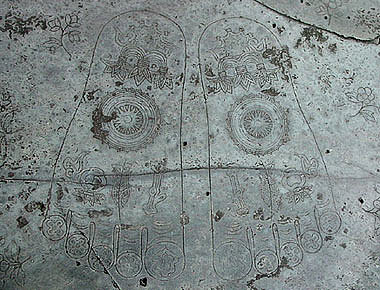
Bussokuseki 仏足石, Zōjōji Temple 増上寺 in Tokyo
Photo courtesy of JAANUS

BELOW TEXT FROM THE MIHO MUSEUM (JAPAN)
www.miho.or.jp/booth/html/doccon/00001126.htm
 As the historical Buddha began to be seen as a superhuman one, the idea developed that he had certain physical attributes different from those of ordinary humans. Eventually thirty-two major signs (lakshanas) and eighty minor characteristics (vyanjanas) were described as distinguishing the physical form of the Buddha, though different texts (sutras) vary in the nature of these signs. Such signs, for example, include his soles being flat and marked with auspicious symbols. As the historical Buddha began to be seen as a superhuman one, the idea developed that he had certain physical attributes different from those of ordinary humans. Eventually thirty-two major signs (lakshanas) and eighty minor characteristics (vyanjanas) were described as distinguishing the physical form of the Buddha, though different texts (sutras) vary in the nature of these signs. Such signs, for example, include his soles being flat and marked with auspicious symbols.
During the earliest period of Buddhist art, when the Buddha was not represented anthropomorphically, the Buddha's footprint was one of the symbols which were used in narrative reliefs depicting the Buddha's life scenes to indicate his personal presence. In the Gandharan region, where the Buddha image in human form was first created, there are indications that the Buddha's footprint was worshipped in the same manner as an iconic figure. A Buddha's footprint at the Archaeological Museum, Swat, in Pakistan, is thought to be the one mentioned in the travel records of the Chinese monks Faxien and Xuanzang, who made their pilgrimages in the fifth and the seventh centuries respectively, and worshipped a Buddha's footprint at the northern Swat.
The present example is a Buddha's footprint carved on a rectangular slab, the border of which is decorated with a band of meandering vines or cords with four-petaled flowers between them. A triratna or three-jewel symbol is on the pad of the big toe, and the other four toe-tips are marked by a swastika. The triratna mark is a felicitous symbol in which a three-pronged, w-shaped element surmounts a circular flower motif; it symbolizes the three jewels of Buddhism -- the Buddha, the Buddhist Law (dharma), and the community of practitioners (sangha). The swastika (svastika in Sanskrit) means "the auspicious". The hooks of the swastikas here do not all face in the same direction, and this variation in the motif is a fascinating aspect of this work. In the center of the sole is a wheel edged with a band of four-petaled flowers. The wheel (dharma-chakra) is a symbol of the Buddha's teachings, or the Buddhist Law, as a perfect circle lacks nothing. Furthermore, the Buddha's teachings penetrate the hearts of the faithful as the wheel turns, and the act of the Buddha preaching a sermon is called "the turning of the wheel." This wheel motif corresponds to the thousand-spoked wheel said to be one of the thirty-two auspicious physical signs of the Buddha and to appear on the soles of his feet and the palms of his hands. There is also a three-jewel symbol on the heel.
When placed flat, the Buddha's footprint is positioned with the toes direct towards the worshippers, as if the Buddha is facing them, and when it is displayed on walls, their toes point downward. The stone of this example is a greenish schist, which includes a great quantity of mica flakes, which sparkle in the light. This kind of stone was frequently used in the region extending from the northern part of Gandhara to Swat.
- The presence of the Buddha is indicated with his footprints as well as the bodhi tree, an umbrella, a throne, and the dharmachakra or wheel of the Law in the reliefs depicting the Budda's life scenes on the railing from Bharhut (the begining of the first century B.C.) and on the gateways of the Great Stupa at Sanchi (the begining of the first century A.D.); See Koezuka 1979, fig. 68, 72 (Bharhut), 26 (Sanchi). <end quote for Miho Museum>

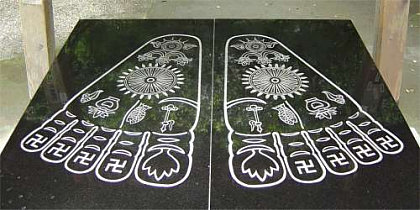
Footprints at Gokurakuji Temple
Made in Heisei Year One (December 1989)
Photo courtesy www.tv-naruto.ne.jp/gokurakuji/bussokuseki.html

Below Text Courtesy of:
sacred-texts.com/shi/igj/igj09.htm
In Anderson's catalogue of Japanese and Chinese paintings in the British Museum, I was recently surprised to find this remarkable statement: "It is to be noted that in Japan the figure of the Buddha is never represented by the feet, or pedestal alone, as in the Amravati remains, and many other Indian art relics." As a matter of fact, the representation is not even rare in Japan. It is to be found not only upon stone monuments, but also in religious paintings, especially certain kakemono (hanging scrolls) suspended in temples. These kakemono usually display the footprints upon a very large scale, with a multitude of mystical symbols and characters. The sculptures may be less common; but in Tokyo alone there are a number of ”Butsu-soku-seki,” or "Buddha-foot-stones."
UNCONFIRMED RESEARCH
Below Text Courtesy of:
www.falundafa.org/intro/0-falun.htm
www.falundafa.org.il/ver_01/english/falunemblem_eng.htm
Some people say that the Svastikam (Swastika) stands for good fortune. Let me tell you that it signifies a Buddha's level. It only exists at the Buddha level. A normal Bodhisattva or an Arhat does not have it. But senior Bodhisattvas, the Four Senior Bodhisattvas, have it. We have found that these Senior Bodhisattvas have far surpassed the level of ordinary Buddhas, and they are even higher than a Tathagata. Beyond the level of Tathagata, there are numerous Buddhas. A Tathagata has only one symbol. Those who have reached beyond the level of Tathagata will have more symbols. A Buddha whose level is twice as high as a Tathagata has two symbols. For those who are still higher, they have three, four, five svastikams, and so on. Some have so many svastikams that they are all over their bodies, including on their heads, shoulders, and knees. When there are too many of them, they will even appear on their palms, fingers, foot arches, toes, etc. As one's level continually increases, one will have more and more symbols. Therefore, the symbol represents a Buddha's status. The higher a Buddha's status, the more symbols a Buddha has.
MORE UNCONFIRMED RESEARCH
www.wsu.edu:8080/~dee/ANCINDIA/ARYANS.HTM
www.iearn.org/hgp/aeti/aeti-1997/swastika.html
In North America, the swastika was a symbol used by the Navajos. The swastika continues today to be an extensively used sign in Buddhism, Jainism and Hinduism. In Buddhism, a swastika represents resignation. Usually found in the images of Buddha on his chest, palms, soles of feet. In Jainism, it delineates their seventh saint, and the four arms are also used to remind the worshiper of the six possible places of rebirth.
To Hindus, the swastika with the arms bent to the left is called the sathio or sauvastika, which symbolizes night, magic, purity, and the destructive goddess Kali. In both Hinduism and Jainism, the swastika or sathio is used to mark the opening pages or their account books, thresholds, doors, and offerings. The swastika was originally the symbol used by the Aryan people, a name which, in Sanskrit means "noble." The Aryans were a group of people who settled in Iran and Northern India. They believed themselves to be a pure race, superior to the other surrounding cultures.
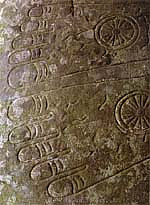
Edo Period (1786), At Kannonji Temple (Kagawa)
興昌寺:観音寺市八幡町二丁目
Courtesy: www.city.kanonji.kagawa.jp/cul/itm/butu.html

THE MAJOR MARKINGS OF A BUDDHA
- 相隨好 (ソウズイコウ) (Jp. = Sōzuekō, Sozueko)
The major and secondary marks on the body of a Buddha (Tathagata)
- 三十二相 (さんじゅうにそう) (Jp. = Sanjūnisō, Sanjuniso)
The 32 major marks
- 八十隨好 (はちじゅうにそう) (Jp. = Hachijūnisō, Hachijuniso)
The 80 secondary marks
32 SIGNS OF BUDDHA (Jp. = Sanjuunisou 三十二相)
The first Buddhist image brought to Japan from Kudara 百済 Korea in the reign of Emperor Kinmei 欽明 (539-571) is recorded in the NIHONSHOKI 日本書紀 to have been a gilt bronze statue. See Early Buddhism in Japan for more details. Gilding of the Buddha's body was not only a decorative technique, it also had religious significance, as one of the Buddha's 32 attributes is that he has golden skin, and that his body gleams with a beautiful golden tone. The 32 attributes (Sanjuunisou 三十二相) of the Buddha originated in ancient Indian tradition and have remained constant and integral elements in Buddhist imagery. They denote the superhuman physical condition of the Buddha. <Source: JAANUS>
WHAT ARE THE 32 SIGNS OF BUDDHA?
These characteristics are listed in a number of Buddhist scriptures, but there are considerable variations among the texts. The most commonly quoted source is the DAI CHIDO RON 大智度論, which is a commentary on the Sūtra on the Perfection of Wisdom (T 1509.25.57c-756b). The text was translated into Chinese by Kumārajīva 鳩摩羅什 (Jp. = Kumarajū; died around 412 CE). The below list comes from the DAI CHIDO RON. <Japanese readings, as presented below, found at JAANUS>
- Sokuge Anbyōryūsō 足下安平立相. Level feet; when walking, not even a hair's space between soles of foot and earth.
- Sokuge Nirinsō 足下二輪相. Thousand-spoked wheel symbol on soles of feet.
- Chōshisō 長指相. Exceptionally long and slender fingers.
- Sokugen Kōbyōsō 足跟広平相. Heels are full sized, broad, round and smooth.
- Shusokushi Manmōsō 手足指縵網相. Webbed toes & fingers; web-like membrane between fingers and toes.
- Shusoku Nyūnansō 手足柔軟相. Pliant hands and feet; skin of hands/feet is soft and smooth.
- Sokufu Kōmansō 足趺高満相. Arched insteps; unusually high insteps.
- Ideien Sensō 伊泥延せん相. Rounded and firm calves (thighs), like those of a royal stag (ideien = type of deer).
- Shōryū Shumashitsusō (Shōritsu Shumashitsusō) 正立手摩膝相. Exceptionally long arms; hands reach knees when standing.
- Onzōsō 陰蔵相. Genitals are retracted (well hidden inside the body).
- Shinkō ōtōsō 身広長等相. Well proportioned body; body height is equal to armspread.
- Mojōkōsō 毛上向相. Body hair is graceful and grows in upward direction.
- Ichi Ichiku Ichimōsō 一一孔一毛相. One hair grows from each pore of skin.
- Konjikisō 金色相. Gold-hued body; body gleams with golden light.
- Jōkōsō 丈光相. Body surrounded by radiant aura; body emits halo of light extending outward about three metres.
- Saihakuhisō 細薄皮相. Skin is extremely smooth.
- Shichisho Ryūmansō 七處隆満相. Feet, shoulders, neck, palms, and crown are well-rounded; seven regions of body are full and rounded.
- Ryōyakuge Ryūmansō (Ryōekige Ryūmansō) 両妬腋下隆満相. Sides of body under arms are full; below armpits well filled; not hollow like ordinary people.
- Jōshin Nyoshishisō 上身如獅子相. Upper body shaped like lion; majestic upper body.
- Daijikishinsō 大直身相. Perfectly firm and erect posture.
- Ken Enmansō 肩円満相. Full and well-rounded shoulders.
- Shijūshisō 四十歯相. 40 teeth as white as snow.
- Shisaisō (Shiseisō) 歯斉相. Straight and even teeth, without gaps, equal in size.
- Gebyakusō 牙白相. Four canine teeth that are larger, whiter, and sharper than the others.
- Shishikyōsō 獅子頬相. Lion-jawed; full and firm cheeks, like those of a lion.
- Michūtoku Jōmisō 味中得上味相. Saliva imparts delicious taste to anything that is eaten.
- Daizetsusō 大舌相. Long and flexible tongue; when extended it can touch the hairline.
- Bonjōsō 梵声相. Voice is deep, resonant, pure and strong; can be heard from long distances.
- Shinshōgensō (Shinjōgensō) 真青眼相. Deep blue eyes, like a blue lotus flower.
- Gyūgonshōsō (Gogenshōsō) 牛眼睫相. Long and regular eyelashes, like those of a royal bull.
- Chōkeisō 頂髻相 (Nikkeisō 肉髻相). Bump (protuberance) on top of head, representing wisdom; Sanskrit = Usnisa.
- Byakumōsō 白毛相 (Byakugō 白毫). White-light emitting clockwise curl of hair on forehead; Sanskrit = Urna.

80 Sub-Characteristics of Buddha, 八十種好
80 Minor Markings of Buddha
80 Secondary Signs of Buddha
Jp. = Hachijūnisō, Hachijuniso, Hachijishugō, Hachijuu Shukō, Hachijū Zuigyōgō 八十随形好, and Hachijuu Zuigōsō 八十随好相. Says JAANUS: The 80 auspicious bodily characteristics of Buddha. Applied to images of Buddha (Jp. = Nyorai 如来) and Bodhisattva (Jp. = Bosatsu 菩薩). These physical characteristics represent the mysterious, superhuman nature of the Buddha. They are listed in several Buddhist texts, for example in the DAI CHIDO RON 大智度論, which was translated into Chinese by Kumārajīva 鳩摩羅什 (Jp. = Kumarajū; died around 412 CE), but their content varies considerably from one text to another. The 80 are thought to have been developed later than the Sanjūnisō 三十二相 (the 32 Characteristics of the Buddha), and are more detailed than the latter, although they are sometimes duplicated. The 80 auspicious characteristics are sometimes called Shōsō 小相 (small features) and the 32 characteristics, Daisō 大相 (large features).
Says the Digitial Dictionary of Buddhism: The first sūtra in which the full list of the 80 characteristics is found is perhaps the Abhiniskramana-sūtra 佛本行集經 (Sūtra of the Collection of the Original Acts of the Buddha; Jp. = Butsu Hongyō Shūkyō; T190.3.655a-932a). It is the most comprehensive Buddha biography in the Chinese Buddhist canon and was translated into Chinese by Jñānagupta (Jp. = Janakutta; died approx. 600 CE). Below is a summary translation by S. Beal, which goes as follows.
- finger-nails of copper color
- smooth finger-nails
- prominent finger-nails
- rounded finger-nails
- slender fingers
- well developed fingers
- concealed veins
- unknotted veins
- concealed ankles
- even feet
- gait of a lion
- gait of an elephant
- gait of swan
- gait of a bull
- gait of swaying towards the right
- pleasing gait
- steady gait
- rounded body
- smooth body
- regular body
- pure body
- tender body
- stainless body
- sex organs complete
- body with broad and graceful limbs
- even pace
- youthful body
- zestful body
- lofty body
- well-composed body
- well-proportioned limbs and their parts
- clear and pure sight
- rounded sides of the body
- smooth sides of the body
- not bulging sides of the body
- slim abdomen
- deep navel
- clockwise coiled navel
- agreeable in all respects
- pure conduct
- body free from freckles and black spots
- delicate hands like cotton
- fine hands lines
- deep hands lines
- long hand lines
- not too enlongated mouth
- the mouth resembling the bimba (fruit)
- pliable tongue
- slender tongue
- red tongue
- voice of a roaring elephant or thundering clouds
- articulate, attractive and gentle speech
- rounded canine teeth
- sharp canine teeth
- white canine teeth
- even canine teeth
- regular canine teeth
- prominent nose
- neat nose
- clear eyes
- large eyes
- thick eyelashes
- white and dark section of the eyes beautifully contrast like the petals of a white and dark lotus
- long eyebrows
- soft eyebrows
- even eyebrows
- smooth eyebrows
- thick and long ears
- even ears
- unimpaired hearing
- well-formed forehead
- broad forehead
- well-developed head
- black hair like the black bee
- thick hair
- soft hair
- undisheveled/untousled head
- pliable hair
- fragrant hair
- the palms and soles marked with srivatsa, svastika, nadyavarta, and lalita symbols

Below Chinese list from the Fo Guang Dictionary:
- 指爪狹長,薄潤光潔 Long & thin fingernails, delicate & smooth, emitting pure light
- 手足之指圓而纖長, 柔軟 Round, long, tender toes and fingers
- 手足各等無差,諸指間皆充密。Eyebrows like the new moon, and bright blue in colour (no.3. DAICHIDORON).
- 手足光澤紅潤
- 筋骨隱而不現 Sinews and bones which are covered and not visible
- 兩踝倶隱
- 行步直進,威儀和穆如龍象王 A stride that is straight-forward, with a deportment that is harmonious like a dragon king
- 行步威容齊肅如獅子王
- 行步安平猶如牛王
- 進止儀雅宛如鵝王
- 迴顧必皆右旋如龍象王之擧身隨轉
- 肢節均勻圓妙
- 骨節交結猶若龍盤
- 膝輪圓滿 Kneecaps that are round and full
- 隱處之紋妙好淸淨
- 身肢潤滑潔淨
- 身容敦肅無畏
- 身肢健壯
- 身體安康圓滿
- 身相猶如仙王,周匝端嚴光淨
- 身之周匝圓光,恒自照耀
- 腹形方正, 莊嚴
- 臍深右旋
- 臍厚不凹不凸 A full navel that neither protrudes nor forms a hole
- 皮膚無疥癬 Skin that lacks any irritation
- 手掌柔軟,足下安平 Tender palms and flat soles
- 手紋深長明直
- 唇色光潤丹暉
- 面門不長不短,不大不小如量端嚴
- 舌相軟薄廣長
- 聲音威遠淸澈
- 音韻美妙如深谷響
- 鼻高且直,其孔不現
- 齒方整鮮白
- 牙圓白光潔鋒利
- 眼淨靑白分明
- 眼相脩廣
- 眼睫齊整稠密
- 雙眉長而細軟
- 雙眉呈紺琉璃色
- 眉高顯形如初月
- 耳厚廣大脩長輪?成就
- 兩耳齊平,離衆過失
- 容儀令見者皆生愛敬
- 額廣平正
- 身威嚴具足
- 髮脩長紺靑,密而不白
- 髮香潔細潤
- 髮齊不交雜
- 髮不斷落
- 髮光滑殊妙,塵垢不著
- 身體堅固充實
- 身體長大端直
- 諸竅淸淨圓好
- 身力殊勝無與等者
- 身相衆所樂觀
- 面如秋滿月
- 顏貌舒泰
- 面貌光澤無有顰蹙
- 身皮淸淨無垢,常無臭穢
- 諸毛孔常出妙香
- 面門常出最上殊勝香
- 相周圓妙好
- 身毛紺靑光淨
- 法音隨衆,應理無差
- 頂相無能見者
- 手足指網分明
- 行時其足離地
- 自持不待他衞
- 威德攝一切
- 音聲不卑不亢,隨衆生意
- 隨諸有情,樂爲?法
- 一音演說正法,隨有情類各令得解
- 說法依次第,循因緣
- 觀有情,讚善毀惡而無愛憎
- 所爲先觀後作,具足軌範
- 相好,有情無能觀盡
- 頂骨堅實圓滿
- 顏容常少不老
- 手足及胸臆前,倶有吉祥喜旋德相 (卽卍字)
Source of above English and Chinese list of 80 minor signs:

BELOW TEXT COURTESY OF
Dhammakaya International Society of Belgium

LEARN MORE

Last Update July 2009
|
|